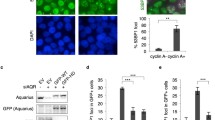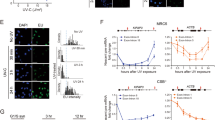Abstract
H/ACA ribonucleoproteins (RNPs) are comprised of four conserved proteins, dyskerin, NHP2, NOP10, and GAR1, and a function-specifying, noncoding H/ACA RNA. H/ACA RNPs contribute to telomerase assembly and stabilization, and posttranscriptional processing of nascent ribosomal RNA and spliceosomal RNA. However, very little is known about the coordinated action of the four proteins in other biologic processes. As described herein, we observed a differential requirement for the proteins in cell proliferation and identified a possible reliance for these factors in regulation of specific DNA damage biomarkers. In particular, GAR1 expression was upregulated following exposure to all forms of genotoxic stress tested. In contrast, levels of the other proteins were either reduced or unaffected. Only GAR1 showed an altered subcellular localization with a shift from the nucleolus to the nucleoplasm after ultraviolet-C irradiation and doxorubicin treatments. Transient siRNA-mediated depletion of GAR1 and dyskerin arrested cell proliferation, whereas loss of either NHP2 or NOP10 had no effect. Finally, loss of dyskerin, GAR1, NHP2, and NOP10, respectively, limited the accumulation of DNA damage biomarkers. However, the individual responses were dependent upon the specific type of damage incurred. In general, loss of GAR1 had the most suppressive effect on the biomarkers tested. Since the specific responses to genotoxic stress, the contribution of each protein to cell proliferation, and the activation of DNA damage biomarkers were not equivalent, this suggests the possibility that at least some of the proteins, most notably GAR1, may potentially function independently of their respective roles within H/ACA RNP complexes.








Similar content being viewed by others
References
Alawi F, Lee MN (2007) DKC1 is a direct and conserved transcriptional target of c-MYC. Biochem Biophys Res Commun 362:893–898
Alawi F, Lin P (2010) Loss of dyskerin reduces the accumulation of a subset of H/ACA snoRNA-derived miRNA. Cell Cycle 9:2467–2469
Alawi F, Lin P (2011) Dyskerin is required for tumor cell growth through mechanisms that are independent of its role in telomerase and only partially related to its function in precursor rRNA processing. Mol Carcinog 50:334–345
Alawi F, Lin P (2013) Dyskerin localizes to the mitotic apparatus and is required for orderly mitosis in human cells. PLoS ONE 8:e80805
Alawi F, Lin P, Ziober B, Patel R (2011) Correlation of dyskerin expression with active proliferation independent of telomerase. Head Neck 33:1041–1051
Alfonso-De Matte MY, Cheng JQ, Kruk PA (2001) Ultraviolet irradiation- and dimethyl sulfoxide-induced telomerase activity in ovarian epithelial cell lines. Exp Cell Res 267:13–27
Bellodi C, Kopmar N, Ruggero D (2010) Deregulation of oncogene-induced senescence and p53 translational control in X-linked dyskeratosis congenita. EMBO J 29:1865–1876
Boulon S, Bertrand E, Pradet-Balade B (2012) HSP90 and the R2TP co-chaperone complex: building multi-protein machineries essential for cell growth and gene expression. RNA Biol 9:148–154
Burger K, Muhl B, Harasim T, Rohrmoser M, Malamoussi A, Orban M, Kellner M, Gruber-Eber A, Kremmer E, Holzel M, Eick D (2010) Chemotherapeutic drugs inhibit ribosome biogenesis at various levels. J Biol Chem 285:12416–12425
Calkins AS, Iglehart JD, Lazaro JB (2013) DNA damage-induced inhibition of rRNA synthesis by DNA-PK and PARP-1. Nucleic Acids Res 41:7378–7386
Ciccia A, Elledge SJ (2010) The DNA damage response: making it safe to play with knives. Mol Cell 40:179–204
Cong YS, Bacchetti S (2000) Histone deacetylation is involved in the transcriptional repression of hTERT in normal human cells. J Biol Chem 275:35665–35668
Darzacq X, Kittur N, Roy S, Shav-Tal Y, Singer RH, Meier UT (2006) Stepwise RNP assembly at the site of H/ACA RNA transcription in human cells. J Cell Biol 173:207–218
Dimitrova DS (2011) DNA replication initiation patterns and spatial dynamics of the human ribosomal RNA gene loci. J Cell Sci 124:2743–2752
Ding WX, Ni HM, Gao W et al (2007) Differential effects of endoplasmic reticulum stress-induced autophagy on cell survival. J Biol Chem 282:4702–4710
Elmore LW, Rehder CW, Di X, McChesney PA, Jackson-Cook CK, Gewirtz DA, Holt SE (2002) Adriamycin-induced senescence in breast tumor cells involves functional p53 and telomere dysfunction. J Biol Chem 277:35509–35515
Fong YW, Ho JJ, Inouye C, Tjian R (2014) The dyskerin ribonucleoprotein complex as an OCT4/SOX2 coactivator in embryonic stem cells. Elife 3. doi:10.7554/eLife.03573
Grozdanov PN, Roy S, Kittur N, Meier UT (2009) SHQ1 is required prior to NAF1 for assembly of H/ACA small nucleolar and telomerase RNPs. RNA 15:1188–1197
Gu BW, Bessler M, Mason PJ (2008) A pathogenic dyskerin mutation impairs proliferation and activates a DNA damage response independent of telomere length in mice. Proc Natl Acad Sci U S A 105:10173–10178
Holt SE, Aisner DL, Shay JW, Wright WE (1997) Lack of cell cycle regulation of telomerase activity in human cells. Proc Natl Acad Sci U S A 94:10687–10692
Jady BE, Ketele A, Kiss T (2012) Human intron-encoded Alu RNAs are processed and packaged into Wdr79-associated nucleoplasmic box H/ACA RNPs. Genes Dev 26:1897–1910
Jeyapalan J, Leake A, Ahmed S, Saretzki G, Tilby M, von ZT (2004) The role of telomeres in Etoposide induced tumor cell death. Cell Cycle 3:1169–1176
Jobert L, Skjeldam HK, Dalhus B, Galashevskaya A, Vagbo CB, Bjoras M, Nilsen H (2013) The human base excision repair enzyme SMUG1 directly interacts with DKC1 and contributes to RNA quality control. Mol Cell 49:339–345
Kim MS, Kim SS, Yoo NJ, Lee SH (2012) Expressional analysis of NOLA1, NOLA2, NOLA3 and DKC1, the core proteins in H/ACA riboproteins, in gastric and colorectal cancers. Pathology 44:576–577
Kirwan M, Beswick R, Walne AJ, Hossain U, Casimir C, Vulliamy T, Dokal I (2011) Dyskeratosis congenita and the DNA damage response. Br J Haematol 153:634–643
Li CT, Hsiao YM, Wu TC, Lin YW, Yeh KT, Ko JL (2011a) Vorinostat, SAHA, represses telomerase activity via epigenetic regulation of telomerase reverse transcriptase in non-small cell lung cancer cells. J Cell Biochem 112:3044–3053
Li S, Duan J, Li D, Ma S, Ye K (2011b) Structure of the Shq1-Cbf5-Nop10-Gar1 complex and implications for H/ACA RNP biogenesis and dyskeratosis congenita. EMBO J 30:5010–5020
Lin P, Mobasher ME, Alawi F (2014) Acute dyskerin depletion triggers cellular senescence and renders osteosarcoma cells resistant to genotoxic stress-induced apoptosis. Biochem Biophys Res Commun 446:1268–1275
Mayer C, Grummt I (2006) Ribosome biogenesis and cell growth: mTOR coordinates transcription by all three classes of nuclear RNA polymerases. Oncogene 25:6384–6391
Meier UT (2006) How a single protein complex accommodates many different H/ACA RNAs. Trends Biochem Sci 31:311–315
Mitchell JM, Wood E, Collins K (1999) A telomerase component is defective in the human disease dyskeratosis congenita. Nature 402:551–555
Montanaro L, Calienni M, Bertoni S, Rocchi L, Sansone P, Storci G, Santini D, Ceccarelli C, Taffurelli M, Carnicelli D, Brigotti M, Bonafe M, Trere D, Derenzini M (2010) Novel dyskerin-mediated mechanism of p53 inactivation through defective mRNA translation. Cancer Res 70:4767–4777
Moore HM, Bai B, Boisvert FM, Latonen L, Rantanen V, Simpson JC, Pepperkok R, Lamond AI, Laiho M (2011) Quantitative proteomics and dynamic imaging of the nucleolus reveal distinct responses to UV and ionizing radiation. Mol Cell Proteomics 10:M111
Moore HM, Bai B, Matilainen O, Colis L, Peltonen K, Laiho M (2013) Proteasome activity influences UV-mediated subnuclear localization changes of NPM. PLoS ONE 8:e59096
Okamoto A, Koike M, Yasuda K, Kakizuka A (2010) Maintaining ATP levels via the suppression of PERK-mediated rRNA synthesis at ER stress. Biochem Biophys Res Commun 394:42–47
Pellizzoni L, Baccon J, Charroux B, Dreyfuss G (2001) The survival of motor neurons (SMN) protein interacts with the snoRNP proteins fibrillarin and GAR1. Curr Biol 11:1079–1088
Rashid R, Liang B, Baker DL, Youssef OA, He Y, Phipps K, Terns RM, Terns MP, Li H (2006) Crystal structure of a Cbf5-Nop10-Gar1 complex and implications in RNA-guided pseudouridylation and dyskeratosis congenita. Mol Cell 21:249–260
Rosenberger S, Thorey IS, Werner S, Boukamp P (2007) A novel regulator of telomerase. S100A8 mediates differentiation-dependent and calcium-induced inhibition of telomerase activity in the human epidermal keratinocyte line HaCaT. J Biol Chem 282:6126–6135
Ruggero D, Pandolfi PP (2003) Does the ribosome translate cancer? Nat Rev Cancer 3:179–192
Schlosser I, Holzel M, Murnseer M, Burtscher H, Weidle UH, Eick D (2003) A role for c-Myc in the regulation of ribosomal RNA processing. Nucleic Acids Res 31:6148–6156
Scott MS, Avolio F, Ono M, Lamond AI, Barton GJ (2009) Human miRNA precursors with box H/ACA snoRNA features. PLoS Comput Biol 5:e1000507
Sieron P, Hader C, Hatina J, Engers R, Wlazlinski A, Muller M, Schulz WA (2009) DKC1 overexpression associated with prostate cancer progression. Br J Cancer 101:1410–1416
Thandapani P, O’Connor TR, Bailey TL, Richard S (2013) Defining the RGG/RG motif. Mol Cell 50:613–623
von Stedingk K, Koster J, Piqueras M, Noguera R, Navarro S, Pahlman S, Versteeg R, Ora I, Gisselsson D, Lindgren D, Axelson H (2013) snoRNPs regulate telomerase activity in neuroblastoma and are associated with poor prognosis. Transl Oncol 6:447–457
Vulliamy T, Beswick R, Kirwan M, Marrone A, Digweed M, Walne A, Dokal I (2008) Mutations in the telomerase component NHP2 cause the premature ageing syndrome dyskeratosis congenita. Proc Natl Acad Sci U S A 105:8073–8078
Walne AJ, Vulliamy T, Marrone A, Beswick R, Kirwan M, Masunari Y, Al-Qurashi FH, Aljurf M, Dokal I (2007) Genetic heterogeneity in autosomal recessive dyskeratosis congenita with one subtype due to mutations in the telomerase-associated protein NOP10. Hum Mol Genet 16:1619–1629
Wang C, Meier UT (2004) Architecture and assembly of mammalian H/ACA small nucleolar and telomerase ribonucleoproteins. EMBO J 23:1857–1867
Woo SH, An S, Lee HC, Jin HO, Seo SK, Yoo DH, Lee KH, Rhee CH, Choi EJ, Hong SI, Park IC (2009) A truncated form of p23 down-regulates telomerase activity via disruption of Hsp90 function. J Biol Chem 284:30871–30880
Wu CH, Sahoo D, Arvanitis C, Bradon N, Dill DL, Felsher DW (2008) Combined analysis of murine and human microarrays and ChIP analysis reveals genes associated with the ability of MYC to maintain tumorigenesis. PLoS Genet 4:e1000090
Wu C, Orozco C, Boyer J, Leglise M, Goodale J, Batalov S, Hodge CL, Haase J, Janes J, Huss JW III, Su AI (2009) BioGPS: an extensible and customizable portal for querying and organizing gene annotation resources. Genome Biol 10:R130
Yoon A, Peng G, Brandenburger Y, Zollo O, Xu W, Rego E, Ruggero D (2006) Impaired control of IRES-mediated translation in X-linked dyskeratosis congenita. Science 312:902–906
Zhang S, Zhou Y, Trusa S, Meng X, Lee EY, Lee MY (2007) A novel DNA damage response: rapid degradation of the p12 subunit of dna polymerase delta. J Biol Chem 282:15330–15340
Zhou C, Gehrig PA, Whang YE, Boggess JF (2003) Rapamycin inhibits telomerase activity by decreasing the hTERT mRNA level in endometrial cancer cells. Mol Cancer Ther 2:789–795
Acknowledgments
We are grateful to Thomas Meier for the GFP construct plasmids. We thank Dana Graves for the HaCaT cells and James Rheinwald for the OKF6-TERT2 cells. This work was supported by funds from National Institutes of Health Grant DE021428, the Abramson Cancer Center Pilot Projects Program P30-CA016520, and the Skin Disease Research Center of the University of Pennsylvania P30-AR057217.
Author information
Authors and Affiliations
Corresponding author
Electronic supplementary material
Below is the link to the electronic supplementary material.
Rights and permissions
About this article
Cite this article
Lin, P., Mobasher, M.E., Hakakian, Y. et al. Differential requirements for H/ACA ribonucleoprotein components in cell proliferation and response to DNA damage. Histochem Cell Biol 144, 543–558 (2015). https://doi.org/10.1007/s00418-015-1359-6
Accepted:
Published:
Issue Date:
DOI: https://doi.org/10.1007/s00418-015-1359-6




